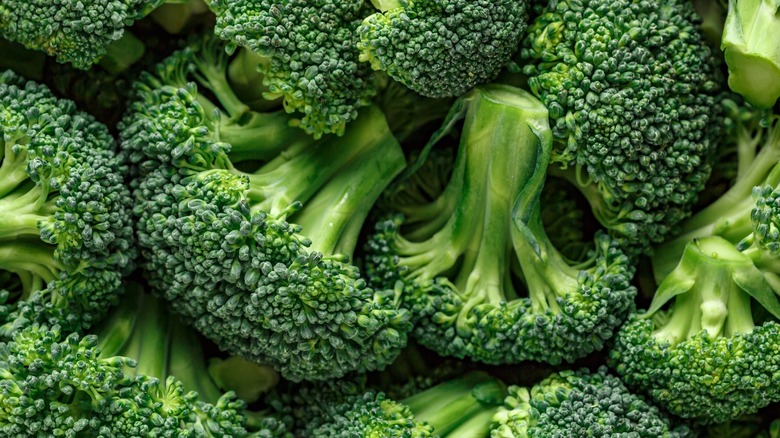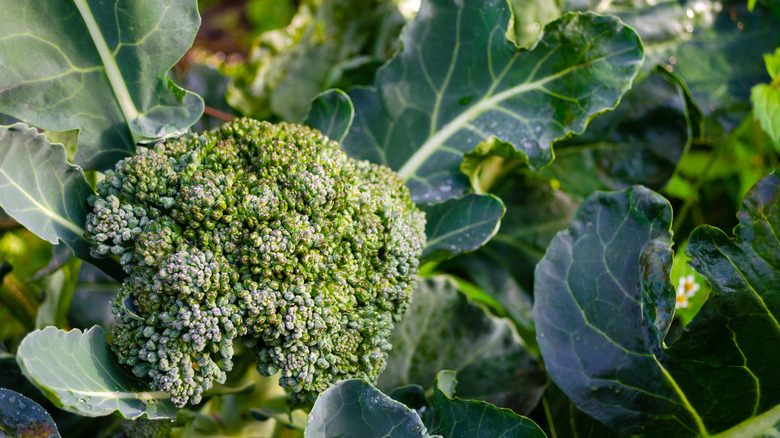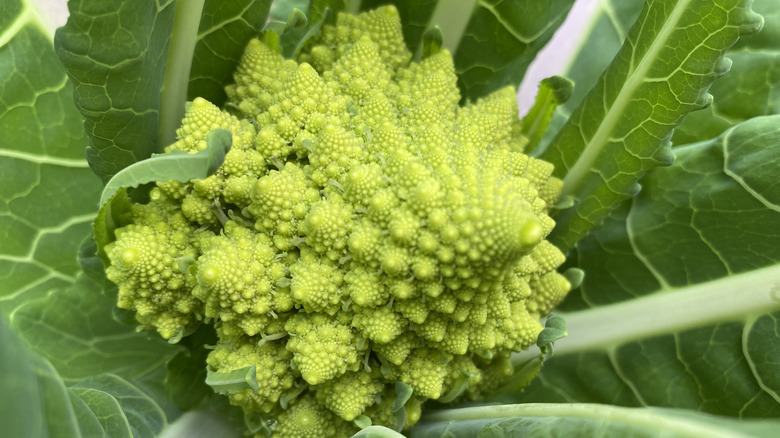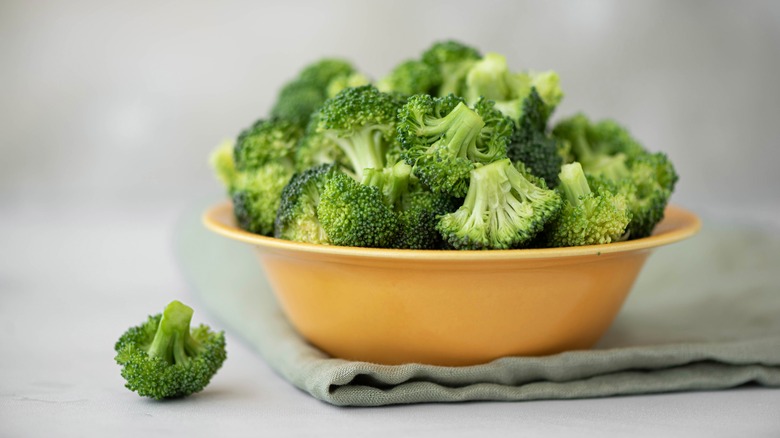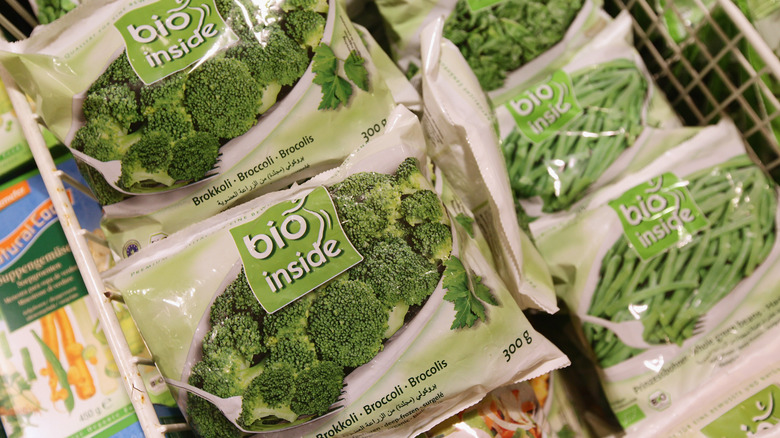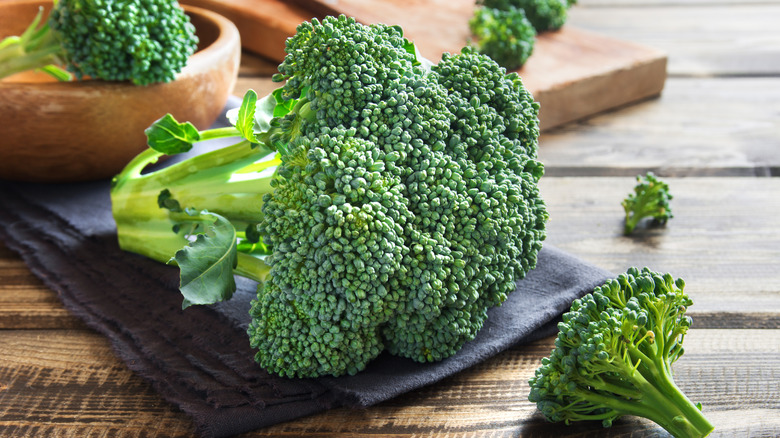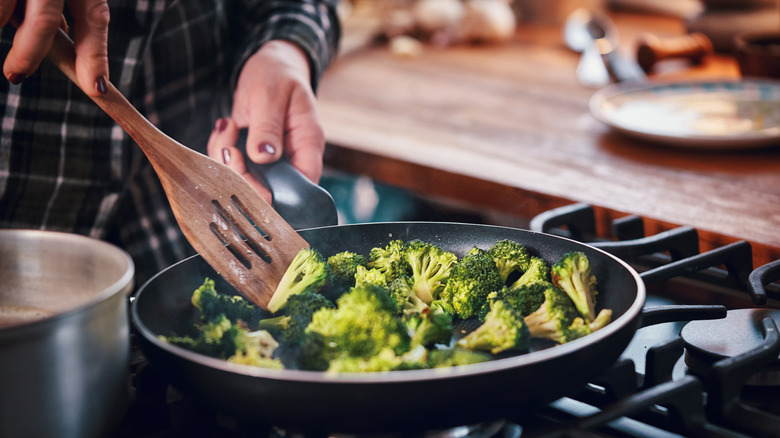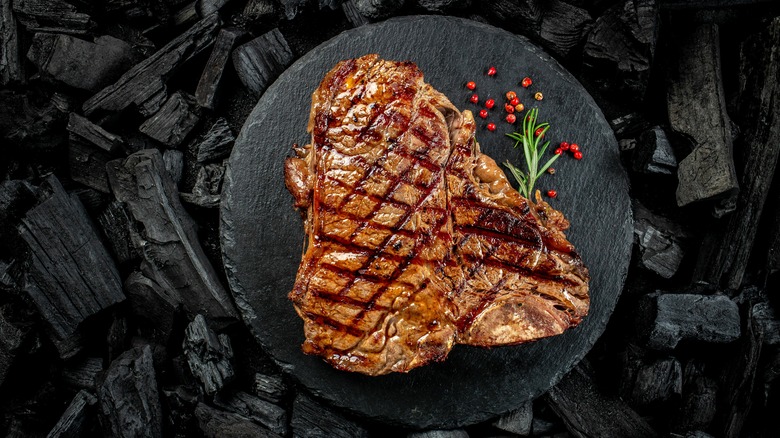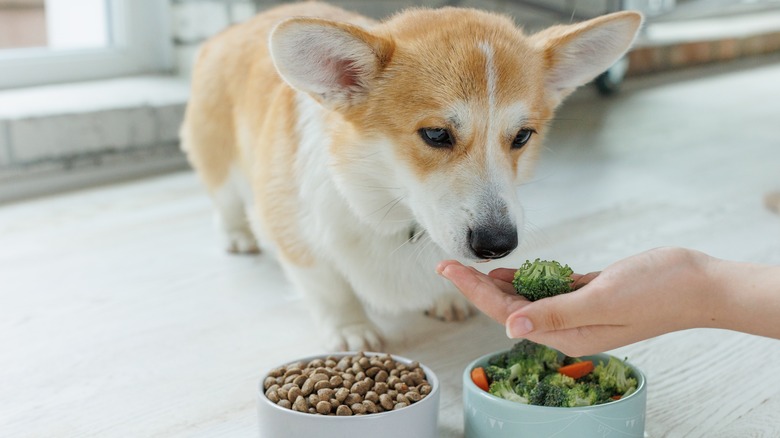False Facts About Broccoli You Thought Were True
Known for its distinctive clusters of green florets and sturdy stalk, broccoli is a member of the cabbage family, which also includes cauliflower, kale, and Brussels sprouts. This striking vegetable is a powerhouse of nutrition, offering an abundance of vitamin C, vitamin K, iron, fiber, and folate. Given its health benefits, it's not surprising that the popularity of broccoli has increased significantly in the past few decades. According to the Agricultural Marketing Resource Center, the annual per capita consumption of broccoli totaled 1.4 pounds in 1980. This increased markedly to 5.2 pounds by 2022, as reported by Statista.
Broccoli is a supermarket staple, reflecting its popularity and ease of incorporation into various dishes. Stores stock broccoli in a variety of forms, including whole fresh heads, pre-cut florets, and individually frozen pieces. Broccoli's versatility extends to the myriad ways it can be prepared and served. The vegetable's adaptability shines in recipes like broccoli casserole, where it's combined with cheese, milk, eggs, canned mushroom soup, and Ritz crackers. Similarly, cream of broccoli soup showcases broccoli's smooth texture and rich flavor, often enriched with a little butter and whipped cream.
Today, broccoli is one of the most beloved vegetables across the globe. However, this green vegetable remains enveloped in a web of misconceptions despite its widespread popularity. Are you ready to discern the truth from the tales when it comes to broccoli? Read on to learn more.
False: Broccoli was masterminded in a laboratory
Like many other vegetables that have been modified throughout the years, broccoli can't be found growing naturally in the wild. However, rather than being an artificial man-made creation, broccoli has been derived from the wild cabbage or wild mustard plant indigenous to the Mediterranean. More specifically, broccoli has been cultivated through selective breeding to enhance certain desirable characteristics, ultimately resulting in the green vegetable we enjoy today.
Broccoli wasn't invented yesterday. The vegetable is the result of many centuries of cultivation and targeted breeding. The story of broccoli as we know it today dates back to ancient Rome, where a version of the vegetable was already being cultivated. However, it wasn't until the 16th century that broccoli journeyed from Italy to other parts of Europe, eventually arriving in the U.S. sometime in the 17th century. Interestingly, broccoli didn't become popular in the States until the 1920s when two brothers from Messina, Italy, started commercially producing the vegetable in California.
False: There's only one type of broccoli
Most of us are familiar with a single kind of broccoli, commonly found in our local supermarkets. Named after Calabria in Italy, Calabrese broccoli comes with a sizable head adorned with multiple florets and a relatively thick stalk. However, beyond the widely recognized Calabrese broccoli, there are diverse broccoli types, each with unique characteristics and culinary uses.
One of the most visually striking broccoli types is Romanesco broccoli, featuring spiral-shaped florets and a unique blend of crunch and earthiness. Broccolini, a hybrid between broccoli and Chinese broccoli, features long, thin stalks and small florets. It's also prized for its sweet flavor. Also known as rapini, broccoli raab has more leafy greens than standard broccoli and features edible buds with a slightly bitter taste. True to its name, purple sprouting broccoli is characterized by its vibrantly hued florets and an underlying sweet flavor.
False: Only the florets of broccoli are edible
When eating broccoli, most people choose to eat the florets and discard the stems. Generally, the florets are preferred for their softer texture and slightly sweeter taste over the stems, which are perceived as tougher and less palatable. However, this habit neglects the nutritional benefit and culinary potential of broccoli stalks, which can be mild tasting and slightly sweet when cooked appropriately. In addition, broccoli stems are just as nutritious as broccoli crowns. They're packed with nutrients, including fiber, vitamin C, vitamin K, calcium, potassium, and folate, making them a healthy and flavorful part of the vegetable.
Before using broccoli stalks, it's best to peel them, especially if you're planning to eat them raw or cook them for only a short amount of time. However, if you're making roasted broccoli stems in an oven, it's generally fine to leave the skin intact. It's also best to chop off the bottom one to two inches off the stalks, as these can be rather tough and chewy. Once cut into coins or batons, broccoli stems make a great addition to stir-fries, salads, and soups. To mix things up, consider pickling broccoli stems as a zesty alternative to traditional pickles.
False: Frozen broccoli is less nutritious than fresh broccoli
Vegetables usually lose their nutritional integrity due to a number of factors, including the way they are handled after harvest and how long they are stored before consumption. However, provided that they're frozen before any significant spoilage takes place, the majority of vegetables retain the bulk of their nutritional value. Broccoli isn't an exception to this rule.
Like other vegetables, when it's frozen right after harvest, broccoli can preserve its vital nutrients, including vitamins, minerals, and antioxidants. Most of the broccoli you find in supermarket freezers has been flash frozen, a process that involves subjecting the vegetable to extremely low temperatures soon after harvesting. Unlike traditional freezing methods, which can form ice crystals and potentially damage the vegetable's cellular structure, flash-freezing broccoli ensures that the vegetable retains its nutrients, as well as flavor and texture.
While freezing broccoli at home may not yield the results of commercial flash freezing, it's still a great way to preserve the cruciferous vegetable. For best results, lay the broccoli crowns on a baking sheet and freeze them individually before transferring them to an airtight container or a freezer bag. This method helps to prevent the broccoli pieces from clumping together, allowing you to use the exact amount needed for your dish without having to thaw the whole batch.
False: Broccoli is bad for weight loss
Not only is broccoli non-fattening, but it can also help you shed a pound or two. This is due to its combination of a low-calorie count with a high fiber content, essential for keeping you feeling full and minimizing the chances of overeating. Additionally, the fiber in broccoli is beneficial for digestive health, further contributing to the vegetable's weight management qualities. Broccoli is also packed with vitamins and minerals, which have been credited with boosting metabolic processes. Furthermore, the vegetable's rich nutritional profile ensures that your body is well-nourished, supporting your overall health as you pursue your weight loss goals.
The way broccoli is prepared can significantly affect your efforts to shed weight. For instance, cooking broccoli in a lot of oil or mixing it with high-calorie dressings can increase the overall calorie content of your broccoli-b ased dish. To get the most benefit from the veggie, try steamed broccoli, pair it with lean protein such as fish or chicken breast, or toss it into salads. Alternatively, you can also eat broccoli as a tasty and satiating mid-meal snack.
False: Raw broccoli is dangerous to eat
Some vegetables are best avoided in their raw form, not only due to taste concerns but also because of potential health risks. Eating uncooked potatoes and eggplants, for instance, may lead to digestive discomfort and other health issues. Similarly, raw cruciferous vegetables, including broccoli, can also be difficult for the body to process. Nevertheless, if eaten in moderation, they shouldn't cause an issue for most people. To safely enjoy raw broccoli, be sure to wash it thoroughly before eating, as it can harbor bacteria and pesticides. Additionally, some people find that marinating raw broccoli can soften it and enhance its flavor.
Along with other cruciferous vegetables, broccoli contains goitrogens, which can interfere with thyroid function. This is because goitrogens can disrupt the thyroid's ability to absorb iodine, which is crucial for the production of thyroid hormones. Nonetheless, when consumed in moderate quantities, broccoli supports general health without affecting thyroid function. According to The Thyroid Dietician, to affect your iodine levels, you would need to consume at least two kilograms of broccoli per day. With this in mind, it's also important to note that cooking broccoli drastically reduces its goitrogenic effect.
False: Cooking broccoli removes all its nutritional value
While the process of cooking broccoli does modify its nutritional content, it's not a simple matter of merely depleting it of value. Cooking can diminish levels of some heat-sensitive nutrients, such as vitamin C and folate, due to exposure to heat and water. However, when it comes to broccoli, the method and length of cooking can make a world of difference. For instance, boiling broccoli in a lot of water on high heat leads to the most substantial loss of vitamins. It's not all bad news, however. Conversely, cooking broccoli can enhance the bioavailability of carotenoids or vitamin A, meaning that it's more readily absorbed by the body.
To retain the maximum amount of broccoli's nutritional value, opt for cooking methods that minimize the use of water, shorten the cooking time, and keep temperatures as low as possible. One of the best ways of cooking broccoli without losing too many nutrients is steaming because it avoids the loss of vitamins and minerals caused by heating the vegetable in water. Similarly, microwaving broccoli with a little water can also minimize nutrient loss, making it a quick and efficient cooking method that preserves a lot of the vegetable's nutritional integrity. Additionally, a 2019 USDA study found that microwaving broccoli in a little water for a short time increased its level of cancer-fighting flavonoids to 128%. Meanwhile, steaming broccoli decreased the vegetable's flavonoids to 88% and boiling to 45%.
False: Broccoli contains more protein than steak
Some vegetarians have suggested that broccoli contains more protein than steak, challenging the assumption that only animal products can be rich in protein. However, this simply isn't the case. While it's true that broccoli is a good source of protein for a plant-based food, there's no question that it contains significantly less protein than beef.
The claim that broccoli is richer in protein than steak is based on comparing the vegetable's protein content to its calorie content, instead of measuring it by weight or volume. For instance, broccoli can appear to have more protein than steak from a calorie-for-calorie standpoint because it's much lower in calories. However, this comparison is deceptive at best since the amount of broccoli needed to match the calories of a serving of steak would be too great for a standard meal.
Hard, cold data doesn't lie. According to USDA's FoodData Central, 100 grams of raw broccoli contains 2.82 grams of protein and 34 calories. This means that the vegetable has 8.3 grams of protein per 100 grams. The same agency reports that 100 grams of steak has 22.1 grams of protein and 131 calories, indicating that it contains 16.9 grams of protein per 100 grams of beef.
False: Broccoli is dangerous for dogs
Concerns about broccoli's safety for dogs are based on its isothiocyanate content, which can potentially irritate the digestive tract of some animals when ingested in large quantities. This said, adding small amounts of broccoli to your dog's diet can supply them with beneficial nutrients without causing any harm. Broccoli is rich in fiber, folic acid, vitamins C and K, and minerals such as chromium and potassium, which can contribute to the overall health of your dog.
So how much broccoli is too much? According to the Chief Veterinary Officer of the American Kennel Club, Dr. Jerry Klein, as a general rule, broccoli shouldn't constitute more than 10% of your dog's diet. Beyond this level, broccoli can start to pose health risks. Dr. Klein cautions that broccoli consumption that exceeds 25% of a dog's diet is deemed toxic.
When it comes to feeding your dog broccoli, moderate amounts of both the vegetable's florets and stems are safe to eat, provided that they have been appropriately prepared. It's best to cut both the broccoli crowns and stalks into bite-sized pieces to prevent choking and make them easier for the dog to digest. It's also a good idea to steam or boil broccoli to make it easier for your dog to chew and swallow.
